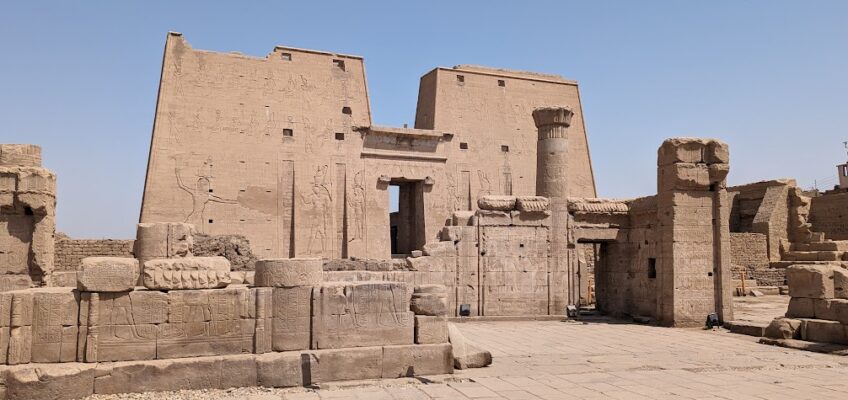Yesterday was a light day activity-wise, but there was one big highlight: our visit to the Temple of Edfu. This wasn’t the most visually-stunning temple we’ve seen, but it is the most intact temple ever discovered in Egypt. So it did not fail to impress.
In fact, the story of the Temple of Edfu is perhaps just as impressive as its visual impact.
But first…
We sailed about four hours in the morning before arriving at Edfu. I used some of that time to catch up on organizing my photos and blogging, And of course enjoying watching the world of Egypt pass by.
Temple of Edfu
We arrived in Edfu around 11:30 am and took a minivan from the dock to the temple, a short drive through a tangle of traffic, with unmarked intersections filled with cars, bikes, and pedestrians daring each other to see who would blink first.
The Temple of Edfu was constructed starting in 237 BCE by Ptolemy III and was completed in 57 BCE by Ptolemy XII. If you remember from the chronology I outlined in my post about the Egyptian Museum, the Ptolemaic kingdom or empire began in 305 BCE, after the death of Alexander the Great in 323. (It lasted until the death of Cleopatra in 30 BCE, when Roman rule commenced.) The Greeks did not impose their religion on the Egyptians. In fact, the Ptolemies gradually adopted Egyptian customs, such as sibling marriage, and they built temples such as the one at Edfu.
The Temple is dedicated to Horus, one of the most important gods in the Egyptian pantheon.
The story of Horus
Before becoming master of the Afterlife, Osiris, oldest son of Geb (earth) and Nut (sky), ruled Egypt and taught agriculture and gave laws and civilization to humans. However, Osiris’s brother, Set, was extremely jealous of him, so Set killed Osiris and cut his body into pieces, which he distributed around Egypt. His sister/wife Isis restored him to life, and they had a son, Horus. Horus and Set had a long battle for the throne. Eventually Horus defeated Set. The hierglyphs on the walls of the temple tell much of this story.
In earlier mythology, Hathor was the mother of Horus, and in later mythology, she still appears in this role. On the walls of the Temple of Edfu, we see a number of depictions of Hathor.
The temple lay buried for two millenia under layers of settlement debris. As a result, it has survived almost in its entirety. It was only rediscovered in 1860.
Boat
Back on our dehabeya, we had a nice chance to get photos in the afternoon. The crew hoisted the sails, and we took a ride around the boat on the tugboat.
The Rosetta Stone
Later in the afternoon, we watched a BBC “documentary” about the Rosetta Stone. I use quotation marks because this was really more of a dramatic reenactment with actors portraying various individuals involved in the discovery and deciphering of ancient Egyptian writing.
The Rosetta Stone was discovered by a French engineer in 1799 in the town of Rosetta, in the Nile delta. It contains the text of a decree issues in 196 BCE by Ptolemy V. The text is written in hieroglyphics, in Egyptian script, and in Greek. When the British defeated the French in the Napoleonic campaign in Egypt, they took posession of the Rosetta Stone and brought it back to England. Today it resides in the British Museum. We saw a replica in the Egyptian Museum. Will the original ever come back home? Doubtful…
The movie depicted a race between English and French scholars to decipher the writing on the Rosetta Stone. Since they knew ancient Greek, that was the starting point. But they didn’t know whether the hieroglyphics were a phonetic alphabet or a pictorial and unspoken language. The French linguist Jean-François Champollion was the one who solved the puzzle. (There are elements of both phonetic and pictorial writing.)
The Rosetta Stone was the essential key to unlocking mysteries about the entire history of ancient Egypt. It is because of this discovery that we know what we know about everything I’ve seen on this journey. Mo studied this and showed us some of the symbols at Edfu.
Dinner
We ended the evening with dinner on the shore. The crew prepared an Egyptian barbecue with all kinds of traditional dishes.
It’s still hella hot, but cruising on the river has been very pleasant, and if it gets too hot on deck, I can always head into the air-conditioned lounge.


Timothy Welch
Thank you! I look forward to your posts and dutifully read them.
Tim
Lane
Thank you Tim! I hope you are enjoying them as much as I always enjoy your travel reports